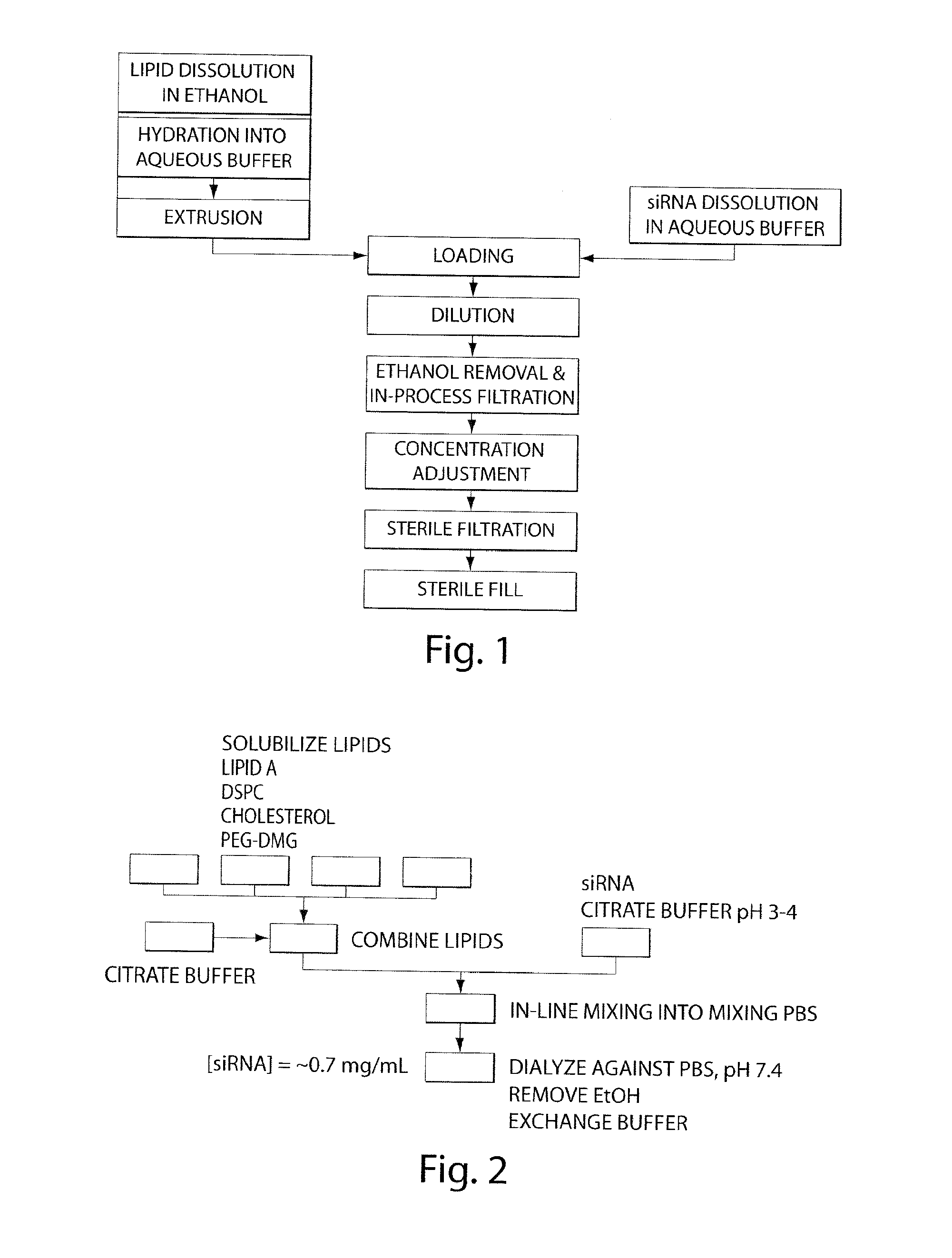Lipid formulation
a technology of lipids and lipid particles, which is applied in the direction of biocide, drug compositions, genetic material ingredients, etc., can solve the problems of reducing the activity of the construct, reducing the ability to gain access to the intracellular compartment, and susceptibility to nuclease digestion in plasma
- Summary
- Abstract
- Description
- Claims
- Application Information
AI Technical Summary
Benefits of technology
Problems solved by technology
Method used
Image
Examples
example 1
Synthesis for precursors of 2,2-Dilinoleyl-4-dimethylaminoethyl-[1,3]-dioxolane
Step 1a: Synthesis of methanesulfonic acid octadeca-9,12-dienyl ester 2
[0305]
[0306]To a solution of the alcohol 1 (26.6 g, 100 mmol) in dichloromethane (100 mL), triethylamine (13.13 g, 130 mmol) was added and this solution was cooled in ice-bath. To this cold solution, a solution of mesyl chloride (12.6 g, 110 mmol) in dichloromethane (60 mL) was added dropwise and after the completion of the addition, the reaction mixture was allowed to warm to ambient temperature and stirred overnight. The TLC of the reaction mixture showed the completion of the reaction.
[0307]The reaction mixture was diluted with dichloromethane (200 mL), washed with water (200 mL), satd. NaHCO3 (200 mL), brine (100 mL) and dried (NaSO4). The organic layer was concentrated to get the crude product which was purified by column chromatography (silica gel) using 0-10% Et2O in hexanes. The pure product fractions were combined and concentr...
example 2
Process 1 for preparing 2,2-Dilinoleyl-4-dimethylaminoethyl-[1,3]-dioxolane (5a)
[0320]
Step 2a: Preparation of Compound 33
[0321]A mixture of compound 32 (10.6 g, 100 mmol), compound 7 (10.54 g, 20 mmol) and PTSA (0.1 eq) was heated under toluene reflux with Soxhlet extractor containing activated 4 Å molecular sieves for 3 h. Removal of solvent then column purification (silica gel, 0-30% EtOAc in hexanes) gave compound 33 (11 g, 90%) as a colorless oil. 1H NMR (400 MHz, CDCl3) δ 5.45-5.24 (m, 8H), 4.30-4.17 (m, 1H), 4.08 (dd, J=7.8, 6.1, 1H), 3.80 (dd, J=10.6, 5.0, 3H), 3.53 (t, J=8.0, 1H), 2.77 (t, J=6.4, 5H), 2.29-2.18 (m, 1H), 2.05 (q, J=6.7, 9H), 1.86-1.74 (m, 2H), 1.59 (dd, J=18.3, 9.7, 5H), 1.42-1.18 (m, 43H), 0.89 (t, J=6.8, 6H). 13C NMR (101 MHz, CDCl3) δ 130.39, 130.36, 130.35, 128.14, 112.80, 77.54, 77.22, 76.90, 75.74, 70.14, 61.08, 37.97, 37.50, 35.56, 31.74, 30.14, 30.13, 29.88, 29.80, 29.73, 29.57, 29.53, 27.45, 27.41, 25.84, 24.20, 24.00, 22.79, 14.30.
Step 2b: Preparati...
example 3
Process 2 for making 2,2-Dilinoleyl-4-dimethylaminoethyl-[1,3]-dioxolane (5a)
[0324]
Step 3a: Preparation of Compound 36
[0325]MsCl (1.1 eq) was added to an ice-cold stirring solution of compound 11 (5 g, 34.2 mmol) and NEt3 (1.2 eq) in DCM (10 mL). After 1 h at r.t., aqueous workup gave a pale yellow oil of 36 (7.7 g, quantitative) which was used without further purification. 13C NMR (CDCl3, 100 MHz) δ=109.2, 72.3, 72.1, 69.1, 67.0, 37.3, 33.4, 26.9, 25.5: Electrospray MS (+ve): Molecular weight for C8H16O5S (M+H)+ Calc. 225.1. Found 225.0.
Step 3b: Preparation of Compound 37
[0326]Compound 36 (3.9 g, 17.4 mmol) was stirred with ethanolic methylamine (33%, 100 mL) over 72 h. Removal of solvent gave a residue which was treated with Cbz-OSu (1.2 eq) and NEt3 (3 eq) for 18 h. Aqueous workup then column chromatography gave compound 37 (5.2 g, 98%).
[0327]Electrospray MS (+ve): Molecular weight for C16H23NO4 (M+H)+ Calc. 294.2. Found 294.0.
Step 3c: Preparation of Compound 38
[0328]A solution o...
PUM
| Property | Measurement | Unit |
|---|---|---|
| Fraction | aaaaa | aaaaa |
| Fraction | aaaaa | aaaaa |
| Fraction | aaaaa | aaaaa |
Abstract
Description
Claims
Application Information
 Login to View More
Login to View More - R&D
- Intellectual Property
- Life Sciences
- Materials
- Tech Scout
- Unparalleled Data Quality
- Higher Quality Content
- 60% Fewer Hallucinations
Browse by: Latest US Patents, China's latest patents, Technical Efficacy Thesaurus, Application Domain, Technology Topic, Popular Technical Reports.
© 2025 PatSnap. All rights reserved.Legal|Privacy policy|Modern Slavery Act Transparency Statement|Sitemap|About US| Contact US: help@patsnap.com



